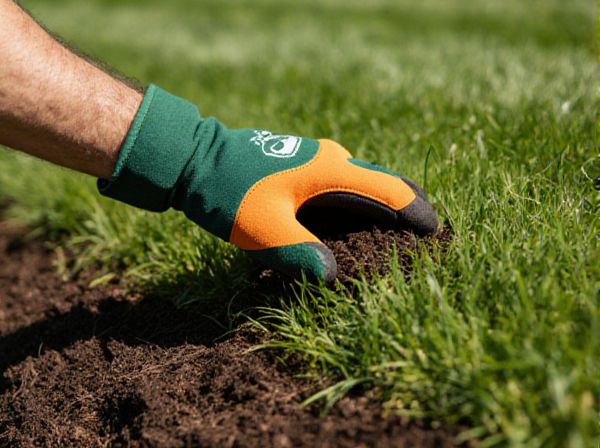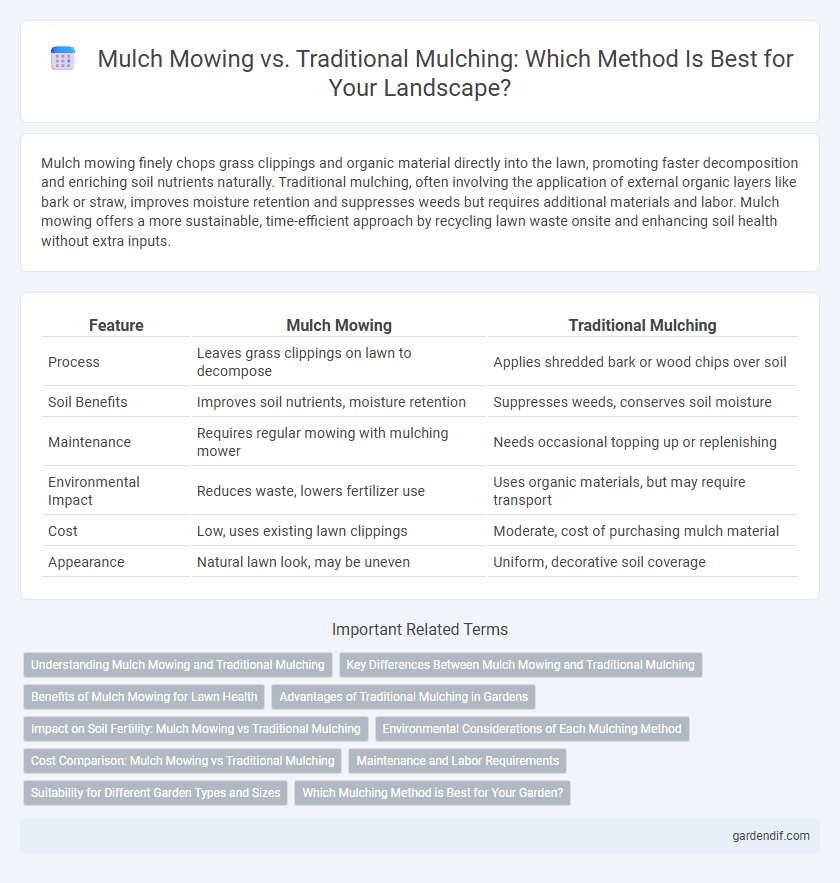
Mulch mowing vs traditional mulching Illustration
Mulch mowing finely chops grass clippings and organic material directly into the lawn, promoting faster decomposition and enriching soil nutrients naturally. Traditional mulching, often involving the application of external organic layers like bark or straw, improves moisture retention and suppresses weeds but requires additional materials and labor. Mulch mowing offers a more sustainable, time-efficient approach by recycling lawn waste onsite and enhancing soil health without extra inputs.
Table of Comparison
| Feature | Mulch Mowing | Traditional Mulching |
|---|---|---|
| Process | Leaves grass clippings on lawn to decompose | Applies shredded bark or wood chips over soil |
| Soil Benefits | Improves soil nutrients, moisture retention | Suppresses weeds, conserves soil moisture |
| Maintenance | Requires regular mowing with mulching mower | Needs occasional topping up or replenishing |
| Environmental Impact | Reduces waste, lowers fertilizer use | Uses organic materials, but may require transport |
| Cost | Low, uses existing lawn clippings | Moderate, cost of purchasing mulch material |
| Appearance | Natural lawn look, may be uneven | Uniform, decorative soil coverage |
Understanding Mulch Mowing and Traditional Mulching
Mulch mowing involves finely chopping grass clippings and leaves, allowing nutrients to return directly to the soil for enhanced lawn health and moisture retention. Traditional mulching, by contrast, typically refers to applying a layer of organic or inorganic material over soil to suppress weeds and reduce evaporation. Understanding the distinct processes helps optimize lawn care strategies by selecting mulch mowing for nutrient recycling and traditional mulching for soil protection.
Key Differences Between Mulch Mowing and Traditional Mulching
Mulch mowing involves finely chopping grass clippings with a specialized mower to return nutrients directly to the soil, enhancing lawn health without waste. Traditional mulching often includes spreading organic material like wood chips or straw across garden beds to conserve moisture and suppress weeds. Key differences include the source of mulch material, the method of application, and their primary functions in lawn care and soil enrichment.
Benefits of Mulch Mowing for Lawn Health
Mulch mowing enhances lawn health by finely chopping grass clippings and returning essential nutrients like nitrogen and potassium directly to the soil, promoting natural fertilization. This process improves soil moisture retention and reduces the need for chemical fertilizers, leading to a stronger, greener lawn. Unlike traditional mulching, mulch mowing minimizes yard waste and supports beneficial microbial activity crucial for healthy turf growth.
Advantages of Traditional Mulching in Gardens
Traditional mulching in gardens enhances soil moisture retention and temperature regulation, creating an optimal environment for root growth and plant health. It effectively suppresses weed growth by blocking sunlight and reducing soil exposure, minimizing the need for herbicides. This method also improves soil fertility over time by decomposing organic materials, enriching the soil with essential nutrients.
Impact on Soil Fertility: Mulch Mowing vs Traditional Mulching
Mulch mowing enhances soil fertility by finely chopping grass clippings and organic matter, which decompose quickly and release nutrients directly into the soil, promoting healthy microbial activity. Traditional mulching, while beneficial, often leaves larger mulch pieces that decompose more slowly and may temporarily immobilize nitrogen, potentially reducing immediate nutrient availability. The accelerated nutrient cycling in mulch mowing supports sustained soil fertility and improves plant growth more efficiently than conventional mulching techniques.
Environmental Considerations of Each Mulching Method
Mulch mowing reduces lawn clippings into tiny pieces that decompose quickly, enriching soil with essential nutrients and minimizing waste accumulation. Traditional mulching often involves removing clippings, which can lead to increased landfill use and the need for synthetic fertilizers to replace lost organic matter. Choosing mulch mowing supports sustainable landscaping by promoting natural nutrient cycling and enhancing soil health without relying on external chemical inputs.
Cost Comparison: Mulch Mowing vs Traditional Mulching
Mulch mowing typically incurs lower labor and equipment costs compared to traditional mulching, as it involves cutting grass and leaving the clippings on the lawn, reducing the need for additional materials. Traditional mulching requires purchasing bags of mulch or organic matter, which increases overall expenses and may involve extra transportation fees. When evaluating long-term costs, mulch mowing offers a cost-effective solution by minimizing maintenance inputs without sacrificing lawn health.
Maintenance and Labor Requirements
Mulch mowing reduces maintenance and labor requirements by finely chopping grass clippings and returning nutrients directly to the lawn, eliminating the need for bagging and disposal. Traditional mulching involves collecting clippings and additional handling, resulting in increased labor and time spent on cleanup. This efficient nutrient recycling in mulch mowing promotes healthier soil with less effort compared to conventional mulching practices.
Suitability for Different Garden Types and Sizes
Mulch mowing is ideal for small to medium-sized gardens with dense vegetation, as it finely chops clippings into uniform mulch, enhancing soil moisture retention and nutrient recycling without the need for raking. Traditional mulching suits larger gardens or landscapes with diverse plantings, allowing for the application of bulk organic materials like bark or wood chips that suppress weeds and moderate soil temperature. The choice depends on garden size, plant type, and maintenance preferences, with mulch mowing offering convenience in regularly maintained lawns and traditional mulching providing long-term soil health benefits in expansive green spaces.
Which Mulching Method is Best for Your Garden?
Mulch mowing uses mower blades to finely chop grass clippings, returning nutrients quickly to the soil, making it ideal for maintaining lawn health and moisture. Traditional mulching spreads organic materials such as wood chips or leaf litter, enhancing soil structure and suppressing weeds over time. Choosing the best mulching method depends on your garden's specific needs: mulch mowing suits turfgrass management, while traditional mulching benefits garden beds and perennial plants.
Mulch mowing vs traditional mulching Infographic

 gardendif.com
gardendif.com